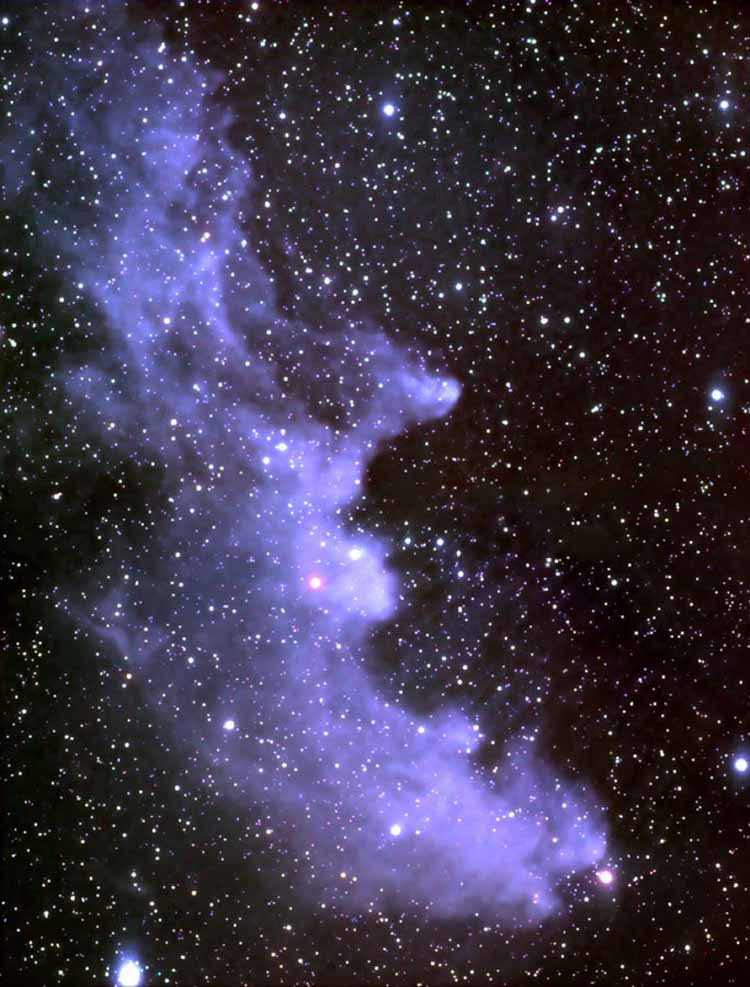
A reflection nebula is a cloud of interstellar dust that reflects the light of a nearby star or stars. The energy from the nearby stars is not enough to ionize the gas of the nebula to create an emission nebula, but is enough to give sufficient scattering to make the dust visible.
Therefore, the frequency spectrum shown by reflection nebulae is similar to that of the illuminating stars. Reflection nebula are very impressive to look at and are often the subject of astrophotography.
Among the microscopic particles responsible for the scattering of the light within reflection nebulae are carbon compounds and compounds of other elements such as iron and nickel. Iron and nickel are often aligned with the galactic magnetic field and cause the scattered light to be slightly polarized.
Unlike emission nebulae, whose reddish glow comes from ionized atoms of gas, reflection nebulae have a bluish cast as their interstellar dust grains reflect blue starlight. The blue light is also more more efficiently scattered by the carbon dust than red light. The same physical process causes Earth’s daytime sky to appear blue.
The idea of a reflection nebula was first put forth by Vesto Slipher in 1912 while analyzing the star Merope in the Pleiades. He suggested that the source of its light is most likely the star itself, and that the nebula reflects light from the star.
Reflection nebulae and emission nebulae are often seen together and are sometimes both referred to as diffuse nebulae.
There are around 500 known reflection nebulae. Reflection nebulae may also be the site of star formation.
Notable Reflection Nebulae
- Pleiades Star Cluster
- Orion Nebula
- Witch Head Nebula
- Trifid Nebula
- Iris Nebula
- Cave Nebula
- Flaming Star Nebula
- Ghost Nebula
- Messier 78
- NGC 2023
Reflection Nebula FAQ’s
How is a reflection nebula formed?
A reflection nebula is created when light from a star is scattered or reflected off a neighboring dust cloud.
What do reflection nebulae look like?
Reflection nebulae have a bluish cast as their interstellar dust grains reflect blue starlight. The blue light is more efficiently scattered by the carbon dust than red light.
Reflection nebula are usually less dense than dark nebulae, and have sizes that are determined by the source of illumination.
What is the difference between an emission nebula and a reflection nebula?
An emission nebula is a cloud of ionised gas, due to high energy photons emitted from a nearby star with the nebula. Reflection nebula are clouds of dust which are simply reflecting the light of a nearby star or stars. The energy from the nearby stars is insufficient to ionize the gas of the nebula to create an emission nebula, but is enough to make the dust visible.
What are the five types of nebulae?
There are five types of cloudy or nebulous objects in the sky: planetary nebulae, emission nebulae, reflection nebulae, dark nebulae and supernova remnants.
Image Sources:
- By NASA/Gary Stevens, picture prepared by Adrian Pingstone – http://antwrp.gsfc.nasa.gov/apod/ap010227.html, Public Domain, https://commons.wikimedia.org/w/index.php?curid=1322057